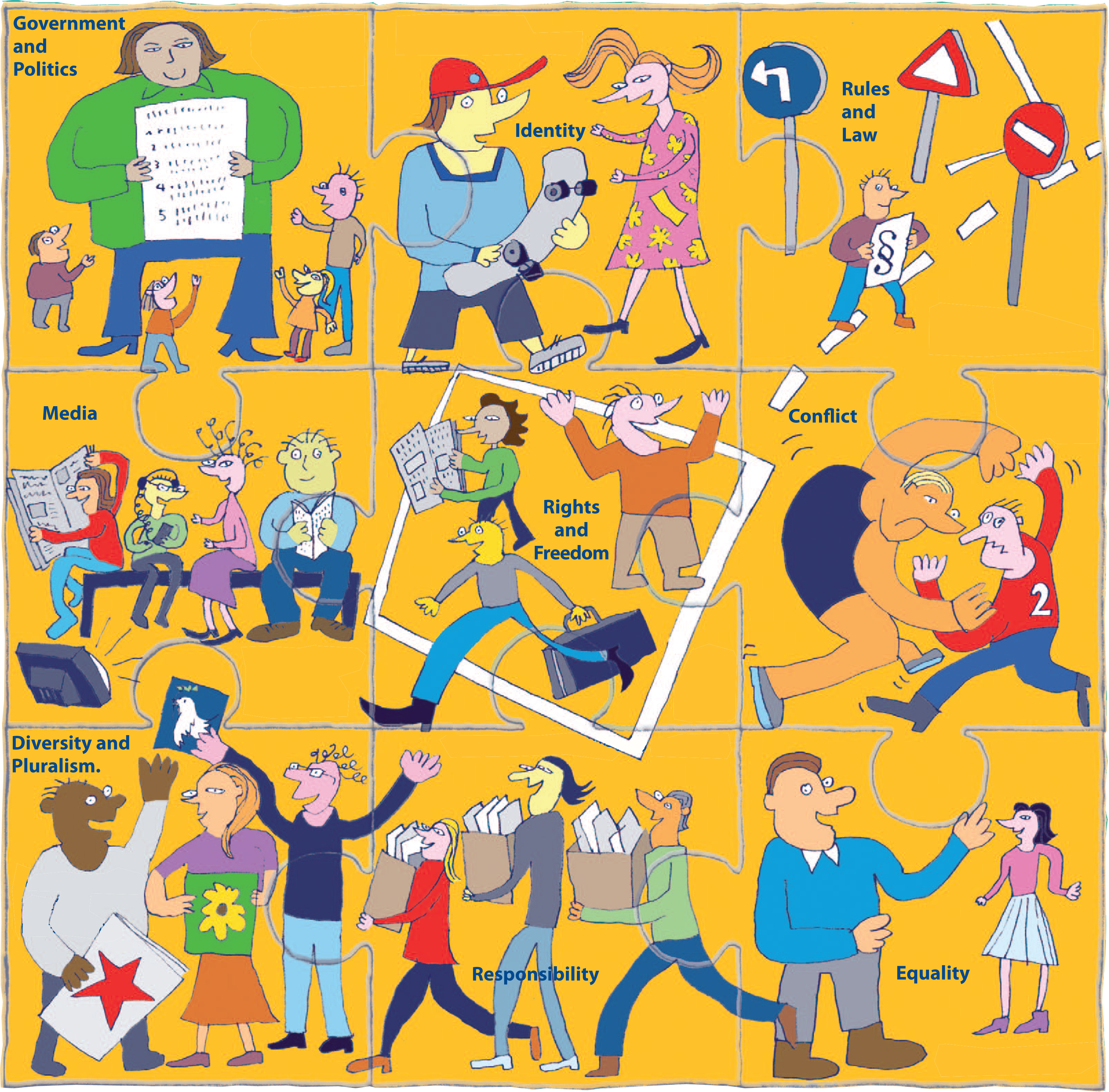Unit 1: Identity – Me in my community
Living Democracy » Textbooks » Unit 1: Identity – Me in my community
Unit 1: Key concept – “Identity” (for primary level)
Background information for teachers: how do students’ self- perceptions influence their identity, their participation in groups and their view of society?
“Identity” in a psychological context relates to self-image (a person’s mental model of him or herself), self-esteem and individuality. Gender identity is an important part of the concept of identity. It dictates to a significant degree how an individual views him or herself, both as a person and in relation to others, and therefore also dictates the potential he or she can bring to a group.
“Identity” in a sociological context focuses on the concept of role behaviour. In this respect, the individual discovers his or her identity through the learning of social roles and his or her personal experience in these roles.
However, “identity” is commonly used to describe personal identity – all the things that make a person unique. Meanwhile, sociologists often use the term to describe social identity, or the collection of group memberships that defi ne the individual.
It becomes evident that identity is very important in different areas. If identity is considered here in the framework of EDC and HRE, it has a specifi c character: if people have clarified their own position they are capable of supporting each other individually and in groups. This is a lifelong process and one which is continuously changing. The clarification of one’s identity or finding one’s identity therefore has to be supported from an early age. This should not take place through didactic means but through offering individuals possibilities to find themselves, with all the advantages and disadvantages which that entails. An open and democratic state can only function if individuals can defend others without losing themselves in the process.
The aim of education for democratic citizenship is to support the development of competences in three areas. This unit has the following competence profile:
| Competence in … | ||
| … political analysis and judgment | … the use of methods | … political decision making and action |
| ** | *** | * |
| Toolbox support | |
| In this unit the following tools from the students’ toolbox will be used. The teacher must decide if some or all of the students need additional preparation to be able to work with these tools. | |
| 0 | Researching in libraries |
| 0 | Researching on the Internet |
| 0 | Carrying out interviews and surveys |
| X | Interpreting images |
| 0 | Mind maps |
| 0 | Creating posters |
| X | Holding exhibitions |
| X | Planning and giving presentations |
| 0 | Preparing overhead transparencies or a PowerPoint presentation |
| 0 | Writing newspaper articles |
| 0 | Putting on performances |
| 0 | Holding debates |
Unit 1: Identity
Me in my community
How do students’ self-perceptions influence their identity, their participation in groups and their view of society?
| Lesson title | Learning objectives | Student tasks | Resources | Methods |
|
Lesson 1: This is what I like |
The students discover their own and others’ abilities and knowledge. They become aware of the effects of gender stereotypes. | The students write down their own preferences and behaviour in four categories. They share their answers with other students and reflect on them. | Paper and pens, printed copies of the handout (“I like and don’t like” table). | Individual and group work, plenary discussion. |
|
Lesson 2: My personal symbols (coat of arms I) |
The students enhance their self-esteem by recognising and valuing their positive aspects. | The students create their personal symbols which will be part of a group coat of arms. They ask themselves questions about their own perception of themselves and use the strengths identified in lesson 1. The students form groups as a pre-requisite for lesson 3. | Tables from the previous lesson, printed copies of the coat of arms (two per student), coloured pens, scissors. | Individual work, forming of groups. |
|
Lesson 3: This is our coat of arms (coat of arms II) |
The students become aware of the potential of their individual strengths that they bring to a group. They agree on a name and motto for the group. | In groups of four, the students explain their personal symbols to the other members of the group. They create a joint coat of arms and agree on a name, a motto and a common symbol for it. The students present their coats of arms to the class. | Copies of the coat of arms from the previous lesson, coloured pens, glue. | Group work (in fours) and a group presentation. |
|
Lesson 4: Individuals and groups |
Through discussion, the students understand that their individual strengths have potential within a group. They understand the concepts of teamwork and division of labour. They can identify groups in society where different strengths have to be combined in order to be successful. | The students talk about their strengths and relate them to other experiences in situations outside of school. In a brainstorming session, they identify situations where different abilities are necessary for the success of the group. | Blackboard or flipchart. | Plenary discussion. |
- Lesson 1: This is what I like
I am a boy/I am a girl and what I like and do is okay...
- Lesson 2: My personal symbols (coat of arms part I)
This is what I am...
- Lesson 3 - This is our coat of arms (coat of arms part II)
We are strong as a group because we are individuals...
- Lesson 4 - Individuals and groups
Strengths of individuals as potential for society...


